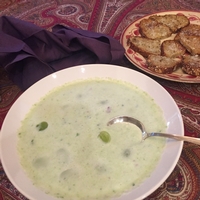It has been a hot summer in the northern hemisphere. On the most sweltering evenings we yearn for cool food, but we’ve had enough chunky chicken salad and tuna sandwiches for a while. We crave a break from all the big, leafy  salads we’ve been grazing on…but we don’t want to turn on the stove or even fire up the grill. In short, what we need is chilled, delicious and nutritious gazpacho.
salads we’ve been grazing on…but we don’t want to turn on the stove or even fire up the grill. In short, what we need is chilled, delicious and nutritious gazpacho.
We might opt for a traditional tomato infused red gazpacho, or for the beautiful emerald-green arugula-based chilled soup we made earlier in the season, but on a recent steamy evening we went with white gazpacho. Refreshingly pale, icy cold and delectable, this lovely soup may not be the antidote to global warming, but it does make the scorching summer a little more pleasant.
White Gazpacho
Make the gazpacho at least 3 hours or even a day ahead to allow the soup to chill thoroughly and the flavors to blend together.
3 English-type seedless cucumbers, peeled and cut in 1 to 2-inch pieces (should yield
about 3 cups chopped cucumber)
2-3 cloves garlic, minced
2 cups chicken stock (or vegetable stock)
1 cup plain, unsweetened yogurt, preferably whole milk
3 tablespoons white wine vinegar (or sherry vinegar or cider vinegar)
1/2 Poblano pepper seeded and chopped (use a whole pepper for spicier results)
1 and 1/2 cups chopped red onion
1/2 cup heavy cream
1 and 1/2 cups green grapes, halved
Put the cucumber, garlic and about one cup of the stock in a blender or food processor. Process for a couple of minutes, scraping down the bowl as needed, until the mixture is thoroughly pulverized. Add 1 teaspoon salt; then pour the mixture into a large bowl or pitcher. Whisk in the yogurt and stir in the vinegar and the remaining stock. Place the chopped poblano pepper and red onion in the blender and pulse on and off, scraping down the bowl as needed, until the mixture is very finely minced but not liquefied. Stir this mixture into the ingredients in the bowl and whisk in the cream. Taste for seasoning and chill thoroughly. To serve, ladle the soup into bowls and add about half of the grapes. Put the remaining grape halves in a small bowl and pass at the table to be added as needed.
We found it very difficult to pair wine successfully with this refreshing but rich soup. At first, we thought that wines with an herbal edge (think New Zealand Sauvignon or Pinot Bianco from northeastern Italy) would work, but we found that the gazpacho made them taste bitter. Then we tried heavier, richer wines (Chardonnay, Semillon, and Viognier), but they seemed sour and more important, cumbersome. We liked a dry bubbly, as much for the textural contrast as the flavors, and a slightly sweet Chenin Blanc, as well as a California Sauvignon (richer than the French and New Zealand renditions we tried), but to be honest, we have to confess that most wines proved disappointing. Then we remembered that Spaniards, who after all invented gazpacho, often drink chilled Vermouth on hot days. We tried one, and it was delicious, as was an aromatized Bianco from Italy. Just as this dish offers unexpected pleasures, so too did our wine tastings with it. Our palates simply did not match our expectations.
More recipes and wine pairings: Wine With…
|
Selection
|
Approx. Price |
Comments |
|
Cocchi, Piedmont (Italy) Aperitivo Americano Bianco NV (Imported by Haus Alperoz)
|
$25 |
This is an aromatized wine, made with Moscato from Asti, fortified with a touch of brandy, and flavored with quinine, orange peel, cinchona bark, and other bittering agents. It is often drunk by itself over ice, which is how we sampled it with our white gazpacho. Because it has its own bitter/ sweet quality, it maintained its personality with the soup—something that other wines we tried had difficulty doing.
|
|
Decoy, Sonoma County (California) Sauvignon Blanc 2017
|
$20 |
While this wine tastes varietally true, it offers greater depth and richness on the palate than Sauvignon Blancs from elsewhere usually do. That extra oomph allowed it to hold its own with the soup, and given its natural exuberance, the bitter note provided by the match proved a welcome addition.
|
|
Dolin, Dry Vermouth Rhône-Alpes (France) Vermouth de Chambéry NV (Imported by Haus Alperoz)
|
$16
|
A simply superb partner for the gazpacho, this bone dry Vermouth tastes clean and pure, with echoes of Alpine herbs that enhance the flavor of the soup. It outperformed every other wine we tried. Serve it ice cold, and let it release ever more aromatic complexity as it warms in your glass. |
|
Lubanzi, Swartland (South Africa) Chenin Blanc 2018 (Imported by Cape Venture)
|
$16 |
Sweeter than most South African Chenin Blancs, this wine’s sugary appeal is what enabled it to work well with the gazpacho. Put simply, the soup tamed it and so enhanced its appeal at the dinner table.
|
|
Simonsig, Stellenbosch (South Africa) Brut Rosé “Kaapse Vonkel” 2016 (Imported by Quintessential)
|
$25 |
As longtime readers know, we like bubbly with soup, in large measure because the fizz makes the wine feel different, allowing it to maintain its identity and not be subsumed by the food, That’s what happened here. The wine may have tasted more interesting on its own, but its sensory appeal came in how it felt in our mouths when we sipped it with the soup.
|
